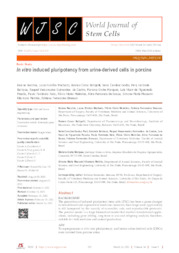In vitro induced pluripotency from urine-derived cells in porcine.
In vitro induced pluripotency from urine-derived cells in porcine.
Author(s): RECCHIA, K.; MACHADO, L. S.; BOTIGELLI, R. C.; PIERI, N. C. G.; BARBOSA, G.; CASTRO, R. V. G. de; MARQUES, M. G.; PESSÔA, L. V. de F.; FANTINATO NETO, P.; MEIRELLES, F. V.; SOUZA, A. F. de; MARTINS, S. M. M. K.; BRESSAN, F. F.
Summary: Methods: The UDCs were reprogrammed in vitro using human or murine octamer-binding transcription factor 4 (OCT4), SRY-box2 (SOX2), Kruppel-like factor 4 (KLF4), and C-MYC, and cultured with basic fibroblast growth factor (bFGF) supplementation. To characterize the putative porcine iPSCs three clonal lineages were submitted to immunocytochemistry for alkaline phosphatase (AP), OCT4, SOX2, NANOG, TRA1 81 and SSEA 1 detection. Endogenous transcripts related to the pluripotency (OCT4, SOX2 and NANOG) were analyzed via reverse transcription quantitative real-time polymerase chain reaction in different time points during the culture, and all three lineages formed embryoid bodies (EBs) when cultured in suspension without bFGF supplementation. Results: The UDCs were isolated from swine urine samples and when at passage 2 submitted to in vitro reprogramming. Colonies of putative iPSCs were obtained only from UDCs transduced with the murine factors (mOSKM), but not from human factors (hOSKM). Three clonal lineages were isolated and further cultured for at least 28 passages, all the lineages were positive for AP detection, the OCT4, SOX2, NANOG markers, albeit the immunocytochemical analysis also revealed heterogeneous phenotypic profiles among lineages and passages for NANOG and SSEA1, similar results were observed in the abundance of the endogenous transcripts related to pluripotent state. All the clonal lineages when cultured in suspension without bFGF were able to form EBs expressing ectoderm and mesoderm layers transcripts. Conclusion: For the first time UDCs were isolated in the swine model and reprogrammed into a pluripotent-like state, enabling new numerous applications in both human or veterinary regenerative medicine.
Publication year: 2022
Types of publication: Journal article
Unit: Embrapa Swine & Poultry
Keywords: Células-tronco, IPSC, Induced pluripotent stem cells, Noninvasive, Pluripotency, Pluripotência, Reprogramming, Suíno, Swine, Urina, Urine
Observation
Some of Embrapa's publications are published as ePub files. To read them, use or download one of the following free software options to your computer or mobile device. Android: Google Play Books; IOS: iBooks; Windows and Linux: Calibre.
Access other publications
Access the Agricultural Research Database (BDPA) to consult Embrapa's full library collection and records.
Visit Embrapa Bookstore to purchase books and other publications sold by Embrapa.

